The
Home Page Selection
If
you require further information on any
print featured here, please contact
us.
When
a print has been sold it will be marked
as Sold.
A
growing archive of selections
from previous Home pages is featured in
the
Home
Page Selection Archive |
|
See
also :
Click
on a thumbnail (left)
to link directly with the entry for that
print, or scroll down to view all the selected
prints from the current Home
Page.
Images
are not to relative scale (see stated dimensions) and also at only modest resolution. If you wish to view extracts of an image at higher resolution, please Contact us.
|
|
|
|
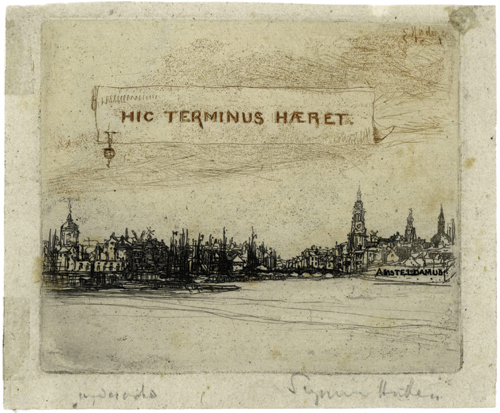
| |
Sir FRANCIS SEYMOUR HADEN P.R.E.
Chelsea 1818 – 1910 Arlesford
Haden was a remarkable man, achieving success in two totally unrelated fields. He was professionally a renowned practising physician and surgeon, and in his spare time, in conjunction with fishing trips, a fine etcher; a founding father of the Modern British school of etching, as well as of the Society of Painter-Etchers itself.
He was President of the Society for thirty years, from 1880 to 1910.
Haden devoted much time to successfully promoting etching as an original creative medium (as in the Dutch Golden Age) in what is today recognised as the 19th century Etching Revival and to winning acceptance and respect for the medium as an art form in its own right at the Royal Academy.
As well as being inspired by Rembrandt as an etcher, Haden contributed significantly to print scholarship in presenting Rembrandt’s etched oeuvre in a catalogue ordered chronologically rather than, as previously, by theme.
Amstelodamum No.1
Schneiderman 41a v/vi (the plate cancelled in the final state);
Harrington 43
101 x 119 mm
Original etching, 1863.
The plate signed and dated, though the digits ‘63’ on this impression not clear.
Fifth state of six as issued for Etudes à l’eau-forte, 1865-66, where it was used as the tailpiece to Burty’s catalogue listing of Haden’s etchings.
This impression signed in pencil and annotated with a single, illegible word.
Printed in black and sanguine on very thin Japanese laid paper.
Small margins.
Slight foxing, mainly verso.
A small restored paper loss at the tip of the top right corner, with related stain, old hinges verso in left margin.
£650
Haden had joined Whistler and Legros on a visit to Amsterdam in 1863 to pay homage to Rembrandt.
Amstelodamum No.1 is a direct tribute to the Dutch old master, reflecting Rembrandt’s technique and composition in his only etching that had the skyline of Amsterdam as its specific theme; Rembrandt’s only etching of the city per se, View of Amsterdam from the northwest (B210).
Haden’s Amstelodamum No.1 is a detail of the waterfront of Amsterdam with the mouth of the river Y, and was initially part of a taller plate (Amsterdam - Petites Vues d’Amsterdam, Schneiderman 41) which showed, in sections arranged in five ‘rows’, one above each other, a longer continuous view of the centre spread of Amsterdam and its harbour.
After only a few proofs were printed Haden removed the two top and two bottom views, leaving only the central one, cut the plate down proportionally, added the title Amstelodamum and the inscription in the sky ‘Hic Terminus Hæret’ -which translates as Here is the end of all things or Terminus (the Roman god of boundaries) abides here.
Haden added this ‘motto’ to two other etchings, both also potential tailpieces for Etudes à l’eau-forte (two versions of views of his hands, Hand holding a crayon and Hands folded ).
The image of Terminus had famously been adopted as a personal symbol by Erasmus of Amsterdam and by extension Haden associated it with the city.
Burty at the conclusion of his catalogue of Haden’s etchings suitably extrapolated the meaning of the motto Here is the end of all things as rest after the conclusion of a duty “performed within the full capacity of his powers”.
Return to top ^ |
|
|
|
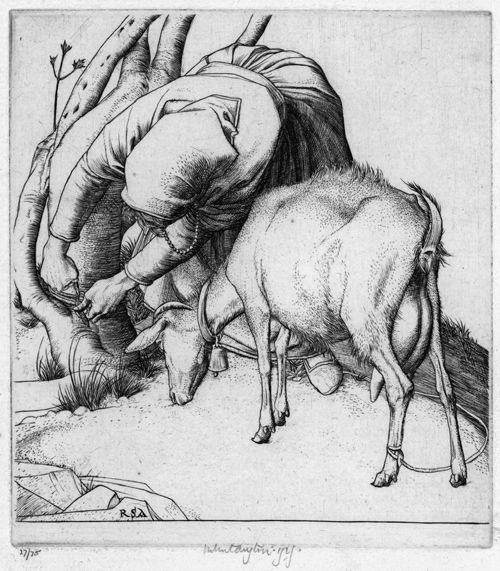 |
|
ROBERT SARGENT AUSTIN P.R.E., R.A., P.R.W.S.
Leicester 1895 – 1973 Burnham Ovary Staithe, Norfolk
Austin began his studies at Leicester School of Art, moving to the R.C.A. in 1913. His studies there, with Frank Short, were interrupted by War service as a gunner in the trenches. He returned to the R.C.A. in 1919. His association with the XXI Gallery as his publisher began the following year, and in 1921 he was elected an Associate of the R.E., all still while a student at the Royal College.
As a winner of the Prix de Rome he spent 1922-1925 in Rome, where he established his mature style and began to use engraving, increasingly his preferred medium after 1925. Italy, in its landscape urban and rural, and its people, provided Austin with many subjects, even in later years.
On his return from Italy he joined the staff of the R.C.A. in 1926, replacing Job Nixon as Malcolm Osborne’s assistant. In 1948, on Osborne’s retirement, he took over as Professor of Engraving at the Royal College and in 1962 succeeded Osborne as President of the R.E., continuing the tradition of somewhat elderly, and previously very long serving, presidents.
Austin was President for eight years, from 1962 to 1970.
Woman tethering a Goat
Campbell Dodgson 81 ix/ix
139 x 125 mm
Original engraving, 1928.
The plate signed with initials.
Signed in pencil, dated and numbered 37/75.
Published state, edition of 75 (though perhaps only 74 impressions were printed).
On cream laid paper watermarked with the initials VGL.
Sold
Return to top ^ |
|
|
|
 |
|
ALFRED PAUL DALOU DRURY P.R.E.
London 1903 – 1987 Nutley, Sussex
Son of the sculptor Alfred Drury, it was perhaps the result of losing an eye in a shooting accident at the age of eleven, that Paul Drury followed a career in two-dimensional graphic art.
He enrolled at Westminster School of Art in 1918 and from 1921 attended Goldsmiths, where successively first Frederick Marriott, then Malcolm Osborne and finally Stanley Anderson were his tutors. Later he returned to Goldsmiths to teach, becoming Principal.
At Goldsmiths College Drury was a fellow student of Graham Sutherland, William Larkins, Bouverie Hoyton and Robin Tanner and shared their discovery and delight in the romantic pastoralist etchings of Samuel Palmer. With Sutherland he was invited to visit Frederick Griggs, another Palmer enthusiast, in Chipping Campden in 1926, taking plates to be printed on the Dover’s House press. However, Drury’s main concern always was portraiture; he made only a few intensely and beautifully needled pastoralist landscapes.
Drury was elected an Associate of the R.E. in 1926 and a Fellow in 1932. He served as President from 1970 to 1975; the first for sixty-five years not to be associated with the Royal College of Art. In his history of the Society Martin Hopkinson describes Drury as a reforming president. Until his Presidency the Society remained much in the late Victorian gentleman’s club mould established by Haden.
Drury wish to make closer contact with the members and sent out a regular ‘letter from the President’, amusingly nicknamed by Harry Ecclestone the Epistle of Paul. Drury tried to extend the breadth of interests of the Society and suggested they absorb the Senefelder Club and welcome in lithographers, but was over-ruled.
It was under his watch that the Print Collectors’ Club decided to return to their original tradition of specially commissioning prints from members for the annual presentation plates, rather than, as had developed over time, selecting the prints from the Annual Exhibitions.
Evening
75 x 99 mm
Original etching, 1925.
Signed in pencil and dated.
Annotated with the title at the foot of the sheet.
Published state, edition of 60.
On antique laid paper with part of an armorial watermark.
Ex John Camfield collection.
£2200
The etching repeats in reverse Drury’s only known wood engraving, unpublished until 1992 when it came to light.
Of the original drawing on which the image is base Drury commented
the “roughout” in quill pen and sepia ink was a simple enforcement of two square ended cottage rooms, two ladders, two tree groups – a bit “Nashy”.
The scene also made him aware of
an extraordinary atmosphere of peace in the evening wintry sunshine .
Exhibited at the R.E. 1941 .
Return
to top ^ |
|
|
|
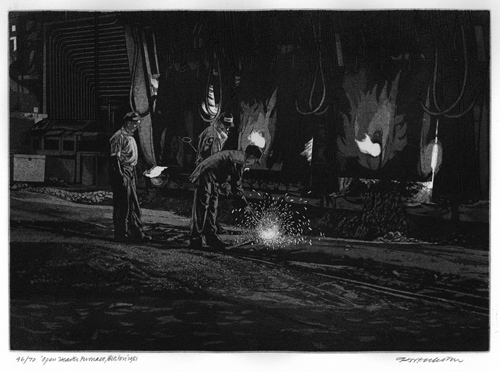 |
|
HARRY NORMAN ECCLESTONE
O.B.E., P.R.E., R.W.S.
Cosely, Bilston 1923 – 2010 Harold Hill, Romford
Eccleston grew up in the Black Country on a small housing estate opposite Caponfield steelworks; and industrial ‘landscape’ would inspire him throughout his career. He was only eleven when he started taking part-time classes at Bilston School of Art and fourteen when he became a fulltime student, also attending Birmingham School of Art.
With a hiatus during the War in which he served as an anti-submarine officer in the Royal Navy, it was 1947 when Eccleston began his studies in the Engraving School of the Royal College of Art, under Robert Austin. A decade later Austin recommended Eccleston as the first in-house Artist-Designer to the Bank of England; a post he held until 1983, designing the Bank’s ‘D’ series of banknotes issued in 1970, the first fully pictorial notes, with images of Isaac Newton, the Duke of Wellington, Florence Nightingale, Shakespeare and Christopher Wren on the reverse of the Queen’s portrait.
Eccleston was elected an Associate of the R.E. in 1948, while still a student at the R.C.A. and a Fellow in 1961. From 1975 to 1989 he served as President, overseeing, during his fourteen years in office, the Society’s move from Conduit Street to the Bankside Gallery. He also urged the acceptance of a wider range of printmaking media and began the process to modify the Society’s name to its present title, Royal Society of Paint-Printmakers, ultimately granted in 1991.
Open Hearth Furnace, Bilston
251 x 356 mm
Original etching and aquatint, 1978.
Signed in pencil, entitled, dated (1981) and numbered 46/70.
Printed on T H Saunders cream wove paper.
£350
Exhibited at the Royal Academy 1982.
One of a series of four etchings commissioned, as the steel making in Bilston was coming towards its end, by William Church, then Works Manager of the Bilston British Steel plant.
Church, a print collector himself, did not feel that photographs, as a record, could do justice to the subject. Ironically, Eccleston had previously been refused permission to work on his own account in the steel plant.
The Bilston plant closed in 1979. As expected and intended, at least half of the edition of 70, sold to the British Steel workforce at Bilston.
In the open hearth furnace, liquid iron (a mixture of iron ore and coke) was refined into steel.
Return
to top ^ |
|
|
|
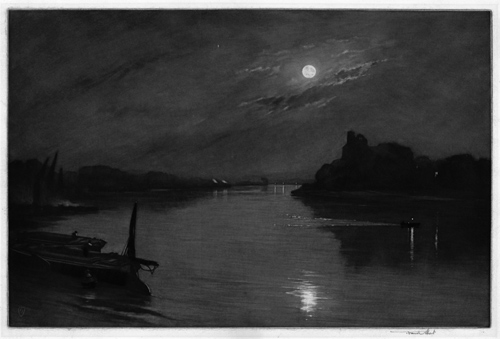 |
|
Sir FRANK JOB SHORT
P.R.E., R.A.
Wollaston, near Stourbridge, Worcs 1857 – 1945 Ditchling, Sussex
Short made his first etching, printed on the family mangle, while he was training to be a civil engineer. When he qualified in 1883 he abandoned engineering for full time art studies and aged twenty-six enrolled at the South Kensington National Art Training School (which would be renamed as the Royal College of Art). At this period Frederick Goulding was in charge of the etching class.
Short also attended life drawing classes at Westminster School of Art, though figures would never have a prominent place in his work; and studied watercolour at the Royal Institute of Painters in Watercolours.
Short’s interest in the tonal techniques of aquatint and mezzotint began in 1884. Until then, in 19th century England, aquatint was associated with the decorative hand-coloured topographical and sporting prints of the 1820’s (superseded in the 1840’s by lithography) and mezzotint was almost totally identified with reproductive engraving.
Short rediscovered both as media for original creative printmaking and it was in mezzotint and aquatint that he made most of his acknowledged masterpieces.
His Diploma print on election in 1885 as a Fellow of the Society of Painter-Etchers (it was granted its Royal status only in 1888) was the original mezzotint The Tide Ebbs, Putney Bridge.
It was largely at Short’s instigation that the Society’s name was enlarged in 1898 to the Royal Society of Painter-Etchers and Engravers.
However, perhaps because it was quicker and more spontaneous, linear etching predominated in his work and leant itself to the play of horizontals and verticals in river scenes and coastal mud flats punctuated with occasional vertical posts, among his recurring subjects.
An influential teacher, beginning as assistant to Goulding at the R.C.A., he took over the class in 1891 and on the Class’s upgrading in 1920 to the School of Engraving, was appointed the first Professor.
Short won the recognition as a printmaker, and the related honours, that Haden had been fighting to achieve. Elected an Associate of the Royal Academy in 1906, and an Academician in 1911, the same year he was knighted. From 1919 to 1932 he served as Treasurer of the Royal Academy. He served on the R.E. Council for fifty-six years and as President for twenty-eight.
During Short’s presidency, 1910 – 1938, wood engravers were admitted to membership; the Print Collectors’ Club was established and the motto, still current, which originated with Whistler, NULLA DIES SINE LINEA (No day without a line) was adopted .
The Night Picket Boat at Hammersmith
Hardie 125
300 x 454 mm
Original mezzotint, 1916.
The plate signed with the ‘shield’ monogram.
Signed in pencil.
Printed on stout wove paper.
Sold
A view from Hammersmith Bridge, delighting in the silvering effects of and reflexions of moonlight and artificial light, with just the odd star.
Short commented
I often saw this effect when doing volunteer Police work at Hammersmith during the War.
Return
to top ^ |
|
|
|
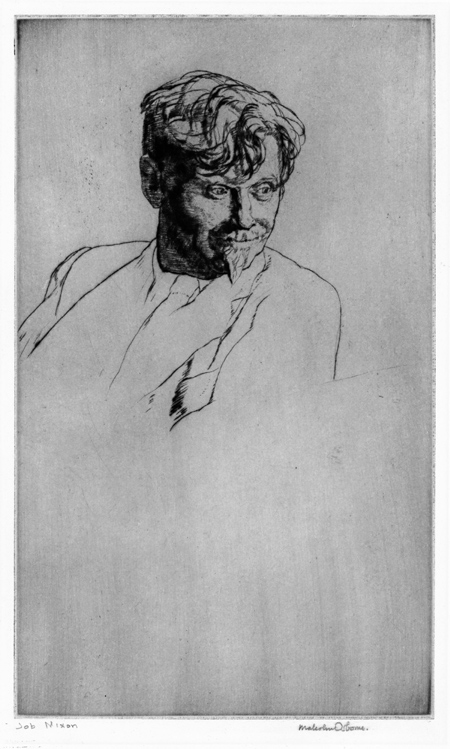 |
|
MALCOLM OSBORNE C.B.E., R.A., P.R.E.
Frome, Somerset 1880 – 1963 London
A student at Bristol School of Art prior to attending the R.C.A 1900-1906, it was only at the Royal College, having begun in the sculpture department, and then tried architecture, that in 1901, in Frank Short’s engraving classes, Osborne found his metier as an etcher.
His first etching was published in 1904, while he was still a student.
In 1905 he was elected an Associate of the R.E. and only four years later a Fellow.
Like the prints of many of his generation who worked in the Etching Boom years, Osborne’s sympathetic landscapes, urban scenes and portraits are sometimes underrated today. Yet his reputation was such that, while abroad in World War One, when he served in the Artists’ Rifles and 6oth Division in France, Salonika and Palestine, he was elected in June 1918 an Associate Engraver of the Royal Academy and in 1926, a Fellow.
Osborne succeeded Frank Short as Professor at the Royal College, on Short’s retirement in 1924, and like Short, he too was an influential and respected teacher for many years.
He was awarded the C.B.E. in 1948.
Osborne also followed Short as President of the R.E. Short stood down in 1938 at the age of eighty, having served for twenty-eight years. Osborne was President for twenty-four years, until 1962, the year preceding his death at the age of eighty-three.
During Osborne’s presidency some book ‘illustrators’ and more modernist printmakers were invited to join, including Anthony Gross, John Copley, Gertrude Hermes, John Buckland Wright; and Muirhead Bone (admiration of whose drypoints is apparent in Osborne’s work in the medium) was made an Honorary Fellow. An important exchange exhibition took place with the Society of American Graphic Artists, so that for the first time the work of the leading American printmakers was shown in London. The category of Senior Fellow was created to free up an allowance to enable an increase in younger members.
Job Nixon
Subsequent to the Salaman PPQ article
315 x 187
Original drypoint, c1926.
Signed in pencil and entitled.
Printed in brown-black ink with plate tone on wove paper.
Sold
Job Nixon (1891-1938) also trained at the R.C.A. just before the First World War. After the War he went to the Slade on an Army scholarship where in 1920 he won the Prix de Rome, the first year that a Rome Prize in Engraving was awarded.
On his return from Rome in 1923 he was elected an A.R.E. and the following year until 1926 he was Osborne’s assistant at the R.C.A.
Return
to top ^ |
|
|
|
|
|
|
|